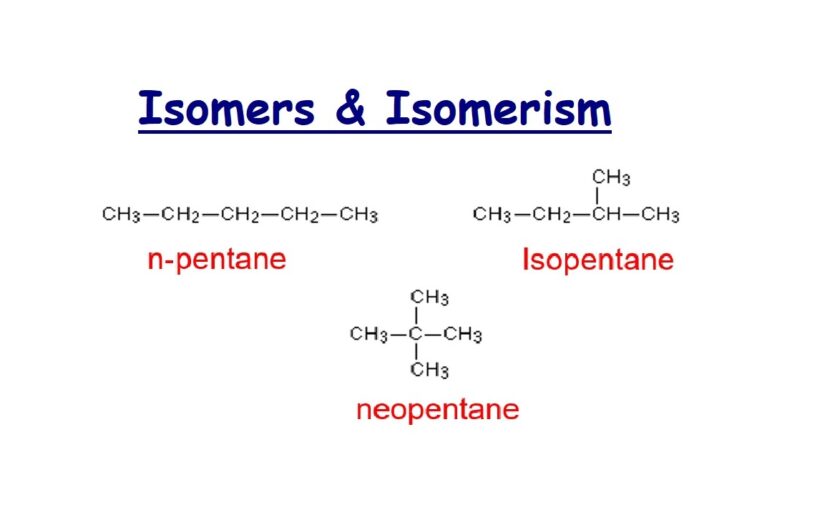Isomers and isomerism are terms used in chemistry to describe different chemical compounds that have the same molecular formula but different structural arrangements or spatial orientations of their atoms. Isomerism is a fundamental concept in chemistry, as it highlights the diversity of chemical compounds that can be formed from the same set of atoms and their reactivity in various chemical reactions.
Here are some examples of Isomers of pentane are n-pentane, Isopentane & neopentane.
Table of Contents
Two main types of isomerism
There are two main types of isomerism: Structural/Constitutional isomerism and Stereoisomerism.
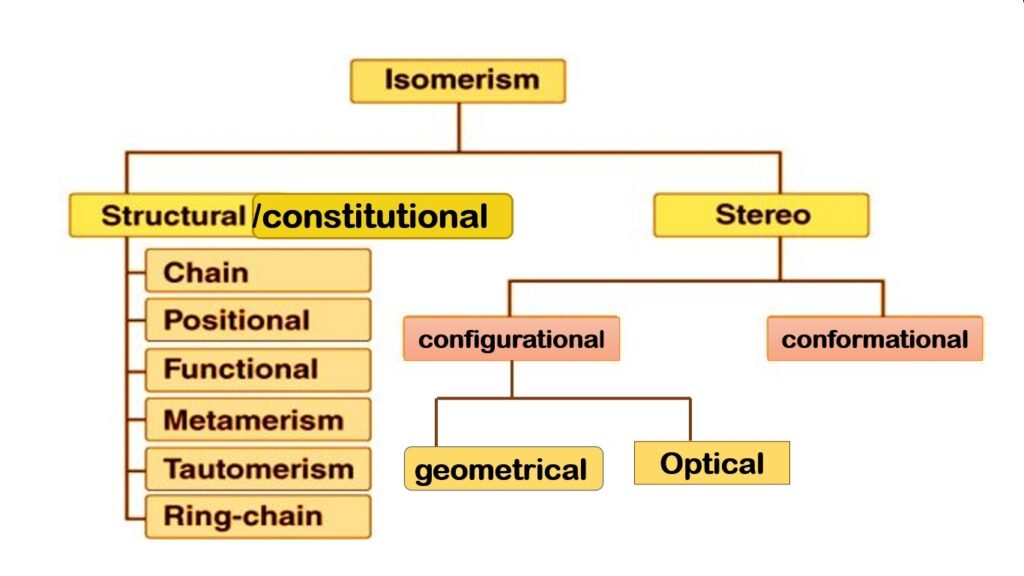
Structural/constitutional
Compounds that have the same molecular formula (i.e., the same number of atoms of each element) but differ in the way their atoms are arranged or bonded to each other. This can include differences in the order of bonding, branching, structural or connectivity patterns within the molecules, or due to variations in the arrangement of atoms or functional groups within a molecule.
Structural isomerism is essential in organic chemistry because it highlights the diversity of compounds that can be derived from the same set of atoms. These isomers often exhibit different physical and chemical properties due to their distinct structural arrangements, which can impact their reactivity, solubility, and biological activity. For example, n-pentane and isopentane are structural isomers with the molecular formula C5H12. There are several types of structural isomerism:
1. Chain Isomerism:
Chain isomers have different arrangements of the carbon skeleton or main chain within the molecule. They can differ in the length of the carbon chain or the branching pattern. For example, butane and isobutane (also called 2-methylpropane) are chain isomers with the molecular formula C4H10.
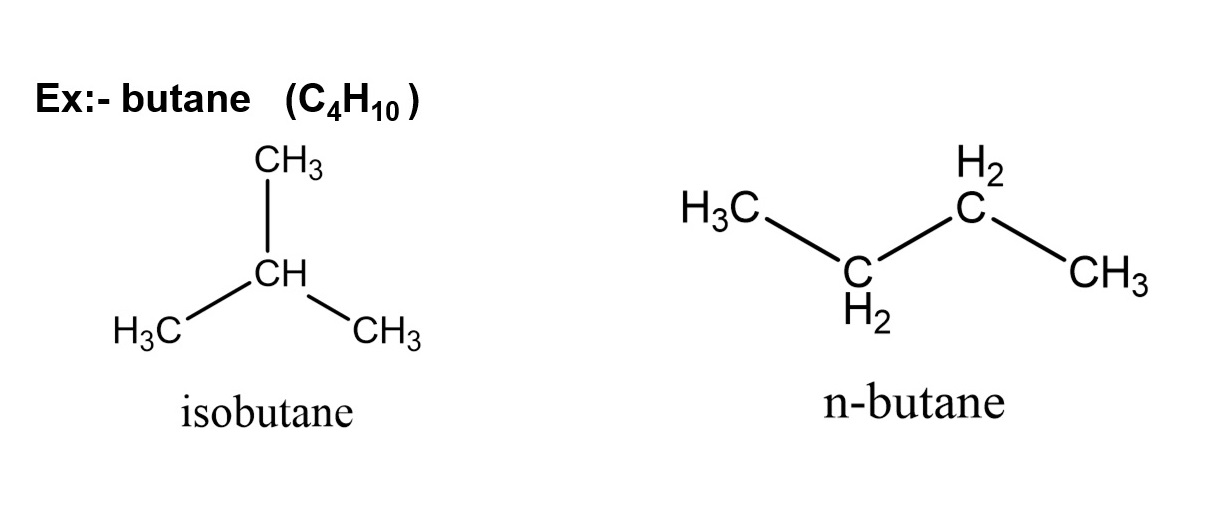
2. Positional Isomerism:
Positional isomers have the same functional groups but differ in the position of those groups along the carbon chain. Example: In propan-1-ol and propan-2-ol (C3H8O), where the hydroxyl group is attached at different positions on the Propane molecule whereas in 1-butene and 2-butene, the double bond is present at different position on the butene molecule.
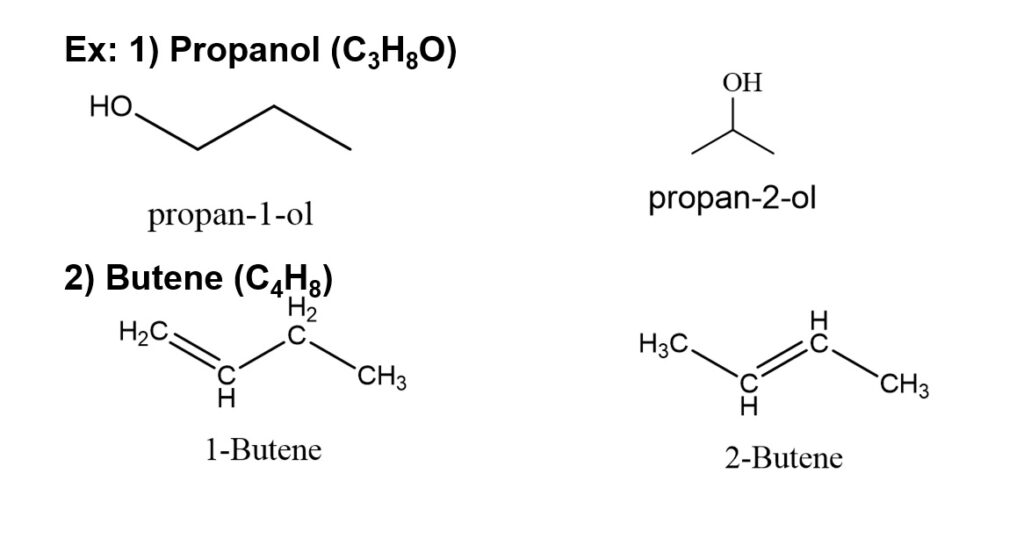
3. Functional Group Isomerism:
Functional group isomers have the same molecular formula but contain different functional groups. For instance, ethanol (CH3CH2OH) and dimethyl ether (CH3OCH3) are functional group isomers. Both have the molecular formula C2H6O but differ in the functional group present (hydroxyl group in ethanol and ether linkage in dimethyl ether). Another example is Acetone and propionaldehyde.

4. Metamerism:
In metamerism, the molecular formula remains the same, but the location of the heteroatoms such as nitrogen, oxygen, or sulfur within the molecule varies that is it involves differences in the way functional groups are arranged within the molecule. The isomers so formed are called as Metamers.
Metamerism is important in organic chemistry because it occurs in various types of organic compounds, including ethers, amines, and amides. In each case, the compounds share the same overall chemical formula but have different connectivity patterns or arrangements of alkyl groups, leading to distinct chemical properties.
Metamerism with respect to alkyl groups involves differences in the arrangement of alkyl (hydrocarbon) groups within a molecule while keeping the rest of the molecular formula and functional groups constant. Alkyl groups are hydrocarbon chains or branches derived from alkanes, and they can be used to create metameric isomers by changing their position or arrangement in the molecule.
Here are some examples of metamerism with respect to alkyl groups:

- Butyl Isomers:
- Isobutyl alcohol (CH3CH2CH(CH3)OH) and sec-butyl alcohol (CH3CH(CH3)CH2OH) are metameric isomers. They both have the molecular formula C4H10O, but the arrangement of the alkyl groups (isobutyl and sec-butyl) is different.
- Propyl Isomers:
- n-Propyl bromide (CH3CH2CH2Br) and isopropyl bromide (CH3CH(CH3)Br) are metameric isomers. They both have the molecular formula C3H7Br, but the position of the alkyl group (propyl or isopropyl) differs.
- Pentyl Isomers:
- n-Pentylamine (CH3CH2CH2CH2NH2) and isopentylamine (CH3CH2CH(CH3)CH2NH2) are metameric isomers. They both have the molecular formula C5H13N, but the arrangement of the alkyl groups (pentyl or isopentyl) varies.
5. Tautomerism:
Tautomers are structural isomers that exist in dynamic equilibrium due to the rapid interconversion of hydrogen atom positions. They have different connectivity arrangements of atoms but can readily transform into each other. An example is keto-enol tautomerism in compounds like keto-enol tautomers.

6. Ring Chain Isomerism:
In cyclic compounds, ring-chain isomerism involves interconversions between compounds with a closed-ring structure and an open-chain structure. For example, glucose and fructose are ring-chain isomers because they can interconvert between a cyclic form and an open-chain form.
Stereoisomerism
Stereoisomers have the same molecular formula and the same connectivity of atoms but differ in their spatial orientation or arrangement in three-dimensional space. On the basis of nature of arrangements of atoms or groups, Stereoisomerism can be classified into two main categories: configuration and conformation.
Configurational Isomerism:
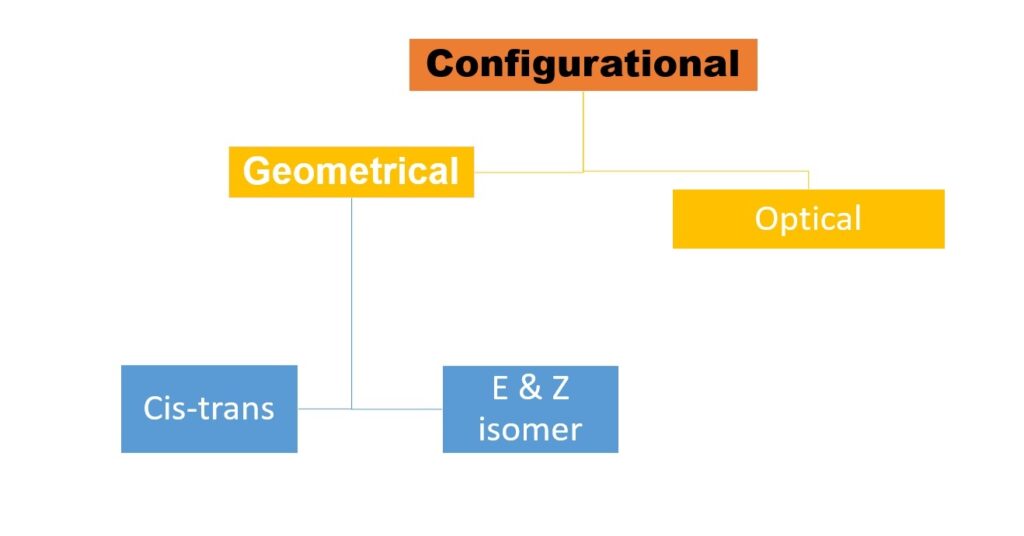
Configuration isomerism is related to the fixed spatial arrangement of atoms or groups within a molecule. It cannot be changed without breaking covalent bonds. Configuration isomers have distinct spatial orientations of atoms or groups around a chiral center (a carbon atom bonded to four different substituents). These isomers are further divided into two subcategories:
1. Geometric (Cis-Trans or E-Z) Isomerism:
Geometric isomers arise from the restricted rotation around double bonds or other rigid structures in a molecule. They are categorized as cis-trans isomers or E-Z isomers based on the arrangement of substituents around a double bond or a similar arrangement
Cis-Trans Isomerism
This occurs when two substituents are on the same side (cis) or opposite sides (trans) of a double bond or a ring structure. Example: Cis- and trans-2-butene (C4H8) are geometric isomers due to the orientation of the hydrogen atoms around the double bond.
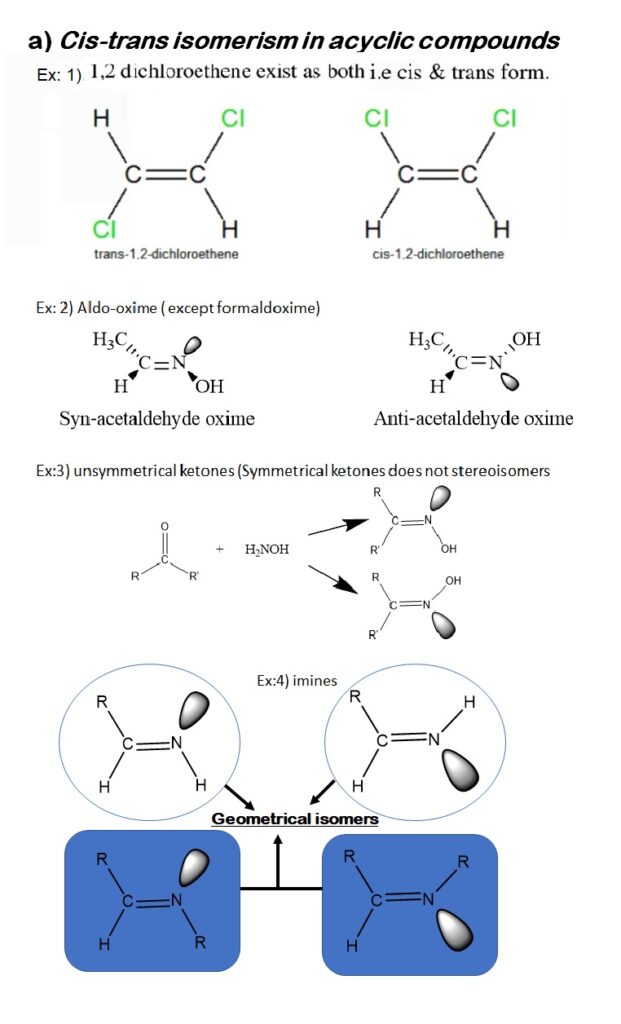
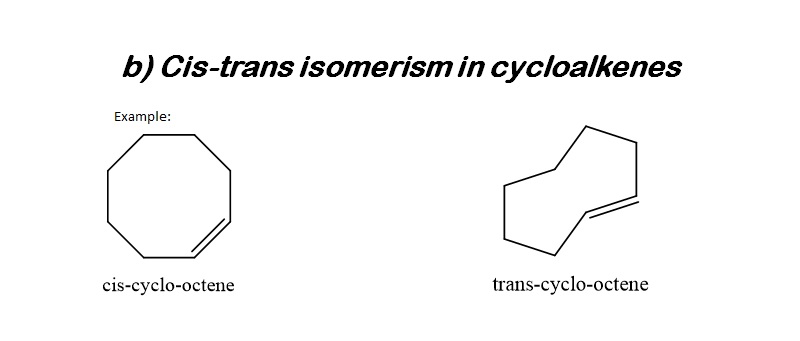
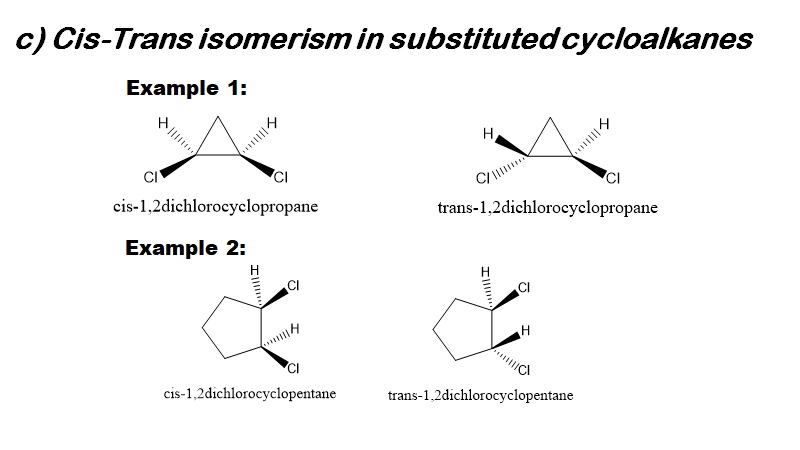
Characteristics of cis-Trans Isomers
- Trans form- molecules are closely packed, more stable & has high MP.
- Cis form- greater solubility, dipole moment, heat of combustion, refractive index & density. It also has the ability to yield cyclic compounds. This is due to closeness of reacting groups to each other.
- Trans form has 0 dipole moment, if the groups have linear moments.
- The ring structure is more or less rigid & may be compared to the double bond in olefinic compds. These can be no rotation around c-c single bonds forming in the ring. Hence cyclic compounds can also exhibit geometrical isomerism.
E-Z Isomerism
It is used when there are more complex molecules with multiple substituents around a double bond.
The Following steps For specifying the configuration are
i.Assign a priority no. 1, or 2 to groups on each C atoms of the double bond.
ii.Compare the priority of groups at 1 C relative to the other.
iii.The symbol ‘E’ ( from German word Entgegen= across / opposite) is assigned to the isomer in which the atoms/groups of higher priority are on opposite side.
iv.The symbol ‘Z’ ( from German word Zusammen= together) is assigned to the isomer in which the atoms/groups of higher priority are on same side.
E represents trans and Z represents cis. Example: E- and Z-isomers of 1,2-dichloroethene (C2H2Cl2) have different spatial arrangements of chlorine atoms around the double bond.
Sequence rules:
- A group gets 1st priority , if the atomic no. is high.
Ex: Priority order: I > Br > Cl > H
Atomic no. 53 35 17 1
2. In case of groups, the priority order is decided on the basis of atomic no. of 1st atom of the group.
Ex: Priority order: -CI > -SO3H > OH > -NHCH3 > -COOH
Atomic no. of 1st atom: 17 16 8 7 6
3. If the priority order of groups cannot be settled on the basis of atomic no. then 2nd atom or the subsequent groups are considered.
Ex: Priority order: -COOH > -CH3
Atomic no. of 2nd atom: 8 1
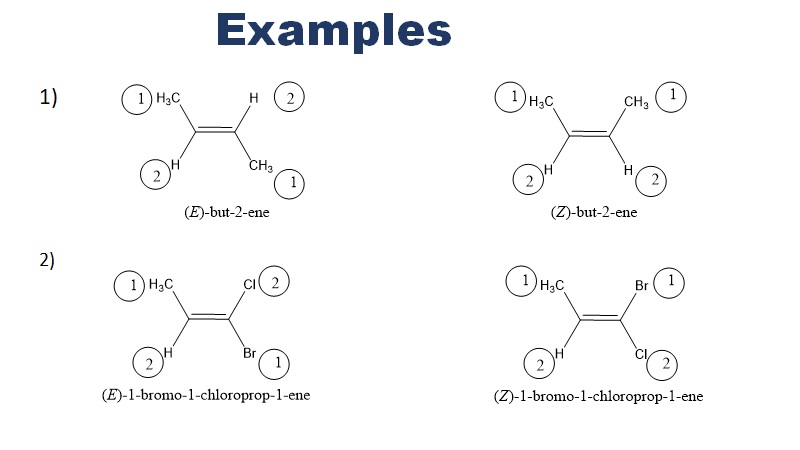
2. Optical (Enantiomer) Isomerism:
Optical isomers, also known as enantiomers, have mirror-image molecular structures but cannot be superimposed onto each other. They are non-superimposable mirror images of each other and arises due to the presence of a chiral center (an atom bonded to four different groups) and exhibit different optical activities. such as optical rotation.
Enantiomers often have identical physical properties (e.g., melting point, boiling point) but may interact differently with other chiral substances, such as polarized light or biological receptors. An example of enantiomers is dextroamphetamine and levoamphetamine, which are two different forms of amphetamine (C9H13N) having identical molecular formulas but opposite optical rotations.
Conformational Isomerism (Conformers or Rotamers):
This is related to the temporary and reversible spatial changes in the arrangement of atoms or groups in a molecule due to rotation around single bonds. Conformational isomers, also called conformers or rotamers, have the same connectivity of atoms but differ in the spatial orientation of groups without breaking any covalent bonds. These isomers are usually interconvertible at room temperature, as they represent different energy minima of the same molecule.
Conformational changes occur due to the rotation of single bonds, particularly those involving sigma bonds, like C-C and C-H bonds. Common examples include the various conformations of cyclohexane (chair, boat, twist-boat, etc.) and the rotation about the C-C bond in butane.
See more articles on organic chemistry in our category -> Organic.

